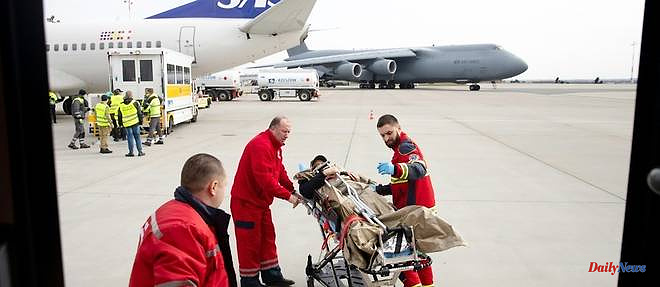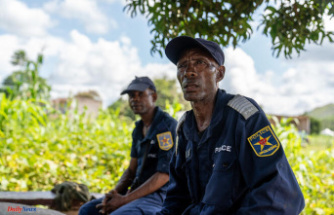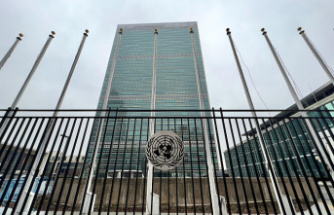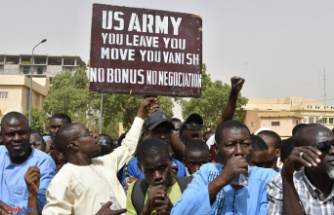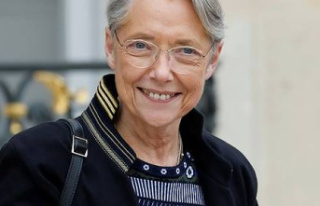The grimaces betray contained pain, pensive glances get lost through the portholes... In this Boeing 737, the passengers are out of the ordinary: in their soul and in their flesh, all have been affected by the war in Ukraine.
"It's the first time I've flown. I would have liked to go to Denmark under normal circumstances, on vacation for example, not to go to the hospital because of a trauma", testifies Mykola Fedirko .
On his wrist, a silicone bracelet with the inscription "Ukraine". On his left leg, metal pins stuck directly into the tibia to stabilize the fracture suffered while defending his country.
A salesman by profession turned soldier by necessity, the emaciated 22-year-old was struck by shrapnel while manning a trench against Russian troops in the Donetsk region.
Accompanied by his girlfriend, "Kolya", his diminutive, is one of some 2,000 patients to have been evacuated from Ukraine to be rerouted all over the continent since the start of hostilities. War wounded for the most part but also civilians requiring heavy treatment.
AFP is the first international media to board one of these medical evacuation flights ("evasan") carried out by Norway as part of a collaboration with the European Union.
“We established this project at the request of Ukraine (…) in order to ease the burden on Ukrainian hospitals,” explains Juan Escalante, head of the (European) Emergency Response Coordination Center ( ERCC).
A mechanism "unprecedented on a continental scale" put in place in "record time", he argues.
In Ukraine, the World Health Organization (WHO) has counted 859 health facilities affected by attacks since the beginning of the Russian invasion on February 24, 2022.
The bombings of hospitals, maternity wards and drug warehouses mean that nearly half a million people are deprived of the medical aid they need every month, according to the Norwegian authorities.
Before performing flea hops - Amsterdam, Copenhagen, Berlin, Cologne and Oslo in two days - to disseminate patients, the SAS Boeing 737 transformed into a flying hospital sets sail for south-eastern Poland and the Rzeszow airport, 70 kilometers from the Ukrainian border.
A hub whose strategic importance is obvious: on either side of the single track, dozens of anti-aircraft missiles point towards the sky, ready to counter any threats from the air.
If it is on this aerodrome that the patients coming from Ukraine are redistributed towards the rest of Europe, it is also here that the Westerners transport weapons and ammunition intended for their Ukrainian allies.
In a cruel crossover, while war cripples are transferred on stretchers in the medicalized Boeing, huge cargo planes disgust pallets of ammunition a few meters further on the same parking area.
On the "evasan" flight, the crew is civilian and the military medical personnel.
In a semblance of normality, an air hostess distributes pizzas, snacks and sodas in the rows.
Also shot in the legs, Oleksiï Radzivil, 28, gulps down his Margherita washed down with a Coke.
Exploding in the ambient gravity, this man with disheveled hair and thin metal glasses, a software engineer before the war, never loses his smile.
Not even when he recovers his senses after a Russian rocket destroyed his vehicle, propelling it several meters in the air, in December in Bakhmout, epicenter of fighting in eastern Ukraine.
"I smiled because I was alive," he recalls.
Since then, he has been through six hospitals in his country.
"I hope that I will be cured (...), that European doctors in the Netherlands will be able to help me," he said.
On the Old Continent, these transfers of patients are presented as a form of contribution to the war effort.
"Their presence here in Spain is another way of fighting Putin," said Spanish Defense Minister Margarita Robles when visiting the military hospital in Zaragoza last year.
With its 20 berths, its monitors, its transfusion and artificial respiration equipment, its countless vials of antibiotics, the Boeing has everything "of a small flying intensive care unit", summarizes Håkon Asak.
This lieutenant-colonel of the Norwegian army health service also proudly wears a blue and yellow "Free Ukraine" bracelet.
"We have never had any fatalities on board, thank God," he said.
"Most of the patients appear to be fine but they are still in serious condition and we know that some of those who were evacuated to different countries did not survive the full course of treatment," he said. 'officer.
Behind the handle, an old veteran.
In his early life, at the twilight of the Cold War, Arve Thomassen was a fighter pilot who intercepted Soviet aircraft in the Arctic.
At 60, this colorful Norwegian says he is happy to end his career with a good cause.
"When you fly passengers to the Mediterranean for sunbathing, it's normal business, I wouldn't say boring but ordinary," he said from his cockpit.
"While that, we take a lot of pride but also humility," he adds.
Over the missions, the impressions accumulate, like so many dagger strokes in the heart: the badly burned, this disfigured man evoking the "broken faces" of 14-18, and then this three-year-old kid suffering from leukemia.
"It's impossible to forget," continues the captain. "One thing is wounded soldiers but suffering children...it always makes a big impression on someone, I think."
For some passengers, a providential sleep can steal a few minutes from their suffering.
Vladyslav Chakhov, lui, ne dort pas.
Entrepreneur turned tank pilot, this dark bearded man with piercing blue eyes has suffered from tetraparesis, a muscle weakness affecting all four limbs, since a shard entered his neck.
"I'm not comfortable with the idea of leaving my country," said the 24-year-old. "At the hospital in Germany, I hope they will get me back on my feet quickly so that I can go back."
03/29/2023 10:48:22 - On board a medicalized Boeing 737 (Poland) (AFP) - © 2023 AFP

